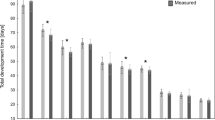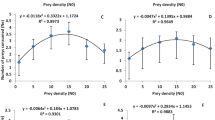Abstract
Experiments were conducted to quantify the effect of several variables on the mortality of insects exposed to an anoxic treatment in order to generate a model linking mortality to these variables. This study aims to explore the possible interest of using such a model to determine the characteristics of treatment (especially duration) needed to guarantee insect mortality with a given level of probability. Trials were performed on Hylotrupes bajulus larvae, which is a widespread species known for its high tolerance to anoxic conditions. The studied variables are the initial mass of the larvae, the treatment temperature (21, 30 and 40 °C), the treatment duration (four durations for each temperature tested) and whether the larva is held in wood or in a petri dish (directly exposed to anoxic atmosphere) during the experiment. It was found that, while the last variable is not correlated with mortality, treatment duration and temperature are significantly and positively correlated with it. Larvae with higher body mass were also shown to have a better resistance to the treatment. Based on these results, a model including insect initial mass, treatment temperature and duration, together with the interaction between these two variables, was determined. This relatively simple model appeared to be a useful tool in overcoming the difficulty in defining the modalities for anoxic treatment in order to reach a given level of mortality.






Similar content being viewed by others
References
Bailey CH, Gurjar AM (1918) Respiration of stored wheat. J Agric Res 12:685–713
Baker AC (1939) The basis for the treatment of products where fruit flies are involved as a condition for entry in the United States. US Department of Agriculture Circular 551
Berzolla A, Reguzzi MC, Chiapinni E (2011) Controlled atmospheres against insect pests in museums: a review and some considerations. J Entomol Acarol Res Ser II 43(2):197–204
Birkenmeyer DR, Dame DA (1970) Effects of carbon dioxide and nitrogen on Glossina morsitans orientalis Vanderplank. Ann Trop Med Parasitol 64(3):269–275
Bliss CI (1934) The methods of probits. Sciences 79(2037):38–39
Brandon J, Hanlon G (2003) A low tech method for insect eradication using ageless TM. WAG Postprints, Arlington
Brokerhof AW (1989) Control of fungi and insects in objects and collections of cultural value. Centraal Laboratorium voor Onderzoek van Voorwerpen van Kunst en Wetenschap, Amsterdam
Child RE (2001) Museums, libraries and archives. The pests: their presence and future. In: Kingsley H, Pinniger D, Xavier-Rowe A (eds) Integrated pest management for collections. Proceedings of 2001: a pest odyssey. James and James, London, pp 130–134
Couey HM, Chew V (1986) Confidence limits and sample size in quarantine research. J Econ Entomol 79:887–890
CPM (2013) Review of phytosanitary security based on a Probit9 treatment standard. Commission on Phytosanitary Measures, Eighth session Rome, 8–12 April
Daniel V, Hanlon G, Maekawa S (1993) Eradication of insect pests in museums using nitrogen. Western Association for Art Conservation Newsletter 3:15–19
Davis R, Jay EG (1983) An overview of modified atmospheres for insect control. Assoc Oper Mill Bull 4026–4029
Dawson J (1988) The effects of insecticides on museum artifacts and materials. In: Zycherman LA, Schrock JR (eds) A guide to museum pest control. Association of Systematics Collections, Washington, pp 135–150
Dendy A (1918) Report on the effect of airtight storage upon grain insects, II. Rep Grain Pests (War) Comm R Soc Lond 3:3
FAO (2011) ISPM 15:2009 draft revision of annex 1: approved treatments associated with wood packaging material. Food and Agriculture Organization of the United Nations, Secretariat of the International Plant Protection Convention, Rome
Florian ML (1988) Ethylene oxide fumigation: a literature review of the problems and interactions with materials and substances in artifacts. In: Zycherman LA, Schrock JR (eds) A guide to museum pest control. Association of Systematics Collections, Washington, pp 151–158
Gialdi E, Ratto L (2002) The SAVE ART project and its outcome: VELOXY®. Cultural Heritage Research: a pan‐European Challenge, 207-209
Gilberg M (1989) Inert atmosphere fumigation of museum objects. Stud Conserv 34(2):80–84
Gilberg M (1991) The effects of low-oxygen atmospheres on museum pests. Stud Conserv 36:93–98
Greenlee KJ, Harrison JF (2004) Development of respiratory function in the American locust Schistocerca americana I. Instar effects. J Exp Biol 207:497–508
Gunn M (2008) Désinsectiser les collections (Disinfestation of museum objects) (In French). La lettre de l’OCIM 115:15–22
Haack RA, Uzunovic A, Hoover K, Cook JA (2011) Seeking alternatives to Probit 9 when developing treatment for wood packaging materials under ISPM No. 15. OEPP/EPPO Bull 41:39–45
Hanlon G, Daniel V, Ravenel N, Maekawa S (1992) Dynamic system for nitrogen anoxia on large museum objects: a pest eradication case study. Second International Conference on Biodeterioration of Cultural Property, Yokohama, Japan
Harmon JD (1993) Integrated pest management in museum, library and archival facilities, 1st edn. Harmon Preservation Pest Management, Indiana (US)
Harrison J, Frazier MR, Henry JR, Kaiser A, Klol CJ, Rascon B (2006) Response of terrestrial insects to hypoxia or hyperoxia. Respir Physiol Neurobiol 154:4–17
Henin J-M, Leyman M, Bauduin A, Jourez B, Hébert J (2014) Phytosanitary treatment of European pallets by microwave: developing a program to ensure compliance with ISPM 15 and monitoring its efficacy on the house longhorn beetle (Hylotrupes bajulus L). Holz Roh-Werkst 72(5):623–633
Hochachka PW (1986) Defense strategies against hypoxia and hypothermia. Science 231:234–241
IBN (2004) EN 14128: Durability of wood and wood-based products—performance criteria for curative wood preservatives as determined by biological tests. Institut Belge de Normalisation, Brussels
IBN (2006) EN 1390: Wood preservatives—determination of the eradicant action against Hylotrupes bajulus (L.) larvae—laboratory method. Institut Belge de Normalisation, Brussels
ICOM-CC (2014) Environmental guidelines IIC and ICOM-CC declaration. http://www.icom-cc.org/332/-icom-cc-documents/declaration-on-environmental-guidelines/. International Institute for Conservation of Historic and Artistic Works, International Council of Museums – Committee for Conservation. Accessed 12 Aug 2015
Jay EG, Cuff W (1981) Weight loss and mortality of three life stages of Tribolium castaneum (Herbst) when exposed to four modified atmospheres. J Stored Prod Res 17(3):117–124
Koestler RJ, Parreira E, Santoro ED, Noble P (1993) Visual effects of selected biocides on easel painting drawings. Paper Conserv 20:22–26
Maekawa S (ed) (1999) Oxygen-free museum cases. The Getty Conservation Institute, Los Angeles
Matheson AC, Parsons PA (1973) The genetics of resistance to long-term exposure to CO2 in Drosophila melanogaster; an environmental stress leading to anoxia. Theor Appl Genet 43:261–268
National Pest Control Association (1965) Old house borer—technical release, 11–65
Navarro S (2006) Modified atmospheres for the control of stored-product insects and mites. In: Heaps JW (ed) Insect management for food storage and processing, 2nd edn. AACC International, St Paul
Neter J, Wasserman W, Kutner MH (1990) Applied linear statistical models, 3rd edn. Irwin, Homewood
Pinniger D (2003) Saving our treasures—controlling museum pests with temperature extremes. Pestic Outlook 14:10–11
Pinniger D, Robinson WH, de Carvalho Campos AE (2011) New developments in pest management for collections in museums and historic houses. In: 7th International conference on urban pests, Ouro Preto, Brazil, 17–21
Reichmuth C, Unger A, Unger W, Blasum G, Piening H, Rohde-Hehr P, Plarre R, Pöschko M, Wudtke A (1993) Nitrogen-flow fumigation for the preservation of wood, textiles, and other organic material from insect Damage. In: Navarro S, Donahaye E (eds) Proceedings of the International Conference on Controlled atmosphere and fumigation in grain storage, Winnipeg, Canada, June 1992. Caspit Press, Jerusalem, pp 121–128
Reierson DA, Rust MK, Kennedy JM, Daniel V, Maekawa S (1996) Enhancing the effectiveness of modified atmospheres to control insect pests in museums and similar sensitive areas. In: Proceedings of the 2nd international conference on urban pests, pp 319–327
Robertson JL, Savin NE, Preisler HK, Russell RM (2007) Bioassays with arthropods, 2nd edn. CRC Press, Boca Raton
Rust MK, Kennedy JM (1993) The feasibility of using modified atmospheres to control insect pests in museums. The Getty Conservation Institute, Los Angeles
Schortemeyer M, Thomas K, Haack RA, Uzunovic A, Hoover K, Simpson JA, Grgurinovic CA (2011) Appropriateness of Probit-9 in development of quarantine treatments for timber and timber commodities. J Econ Entomol 104(3):717–731
Selwitz C, Maekawa S (1998) Inert gases in control of museum insect pest. The Getty Conservation Institute, Los Angeles
Soderstrom EL, Mackey BE, Brandl DG (1986) Interactive effects of low-oxygen atmospheres, relative humidity, and temperature on mortality of two stored-products moths (Lepidoptera: Pyralidae). J Econ Entomol 79(5):1303–1306
Unger A, Schniewind AP, Unger W (2001) Conservation of wood artifacts: a handbook. Springer, New York
Upitis E, Monro HAU, Bond EJ (1973) Some aspects of inheritance of tolerance to methyl bromide by Sitophilus granarius (L.). J Stored Prod Res 9:13–17
Valentin N (1993) Comparative analysis of insect control by nitrogen, argon and carbon dioxide in museum, archive and herbarium collections. Int Biodeterior Biodegradation 32:263–278
Valentin N (1998) Preservation of historic materials by using inert gases for biodeterioration control. In: Maekawa S (ed) Oxygen-free Museum cases. The Getty Conservation Institute, Los Angeles
Valentin N (2003) Non-toxic methods and systems to control biodeterioration in historic objects of large size, Cultural heritage research: a Pan-European challenge. In: Proceedings of the 5th EC conference, May 16–18, 2002, Cracow, Poland. European Communities; ICSC, pp 52–56
Valentin N, Preusser F (1990) Insect control by inert gases in museums, archives and libraries. Restaurator 11:22–33
Weisberg S (1980) Applied linear regression. Wiley, New York
Williams J (1991) A literature survey of non-chemical approaches to disinfesting museums and archives. In: Koestler R (ed) Biodeterioration of cultural property. Elsevier applied science, London
Zhou S, Criddle RS, Mitcham EJ (2000) Metabolic response of Platynota stultana pupae to controlled atmospheres and its relation to insect mortality response. J Insect Physiol 46:1375–1385
Acknowledgments
We thank the Royal Institute for Cultural Heritage for lending us the VELOXY during the experiments. We also thank the team of the Laboratory of Wood Technology from the Public Service of Wallonia, where the experiments were conducted, for their help. We thank Cécile Verheyen for her assistance during this study.
Author information
Authors and Affiliations
Corresponding author
Ethics declarations
Conflict of interest
The authors declare that they have no conflict of interest.
Rights and permissions
About this article
Cite this article
de Streel, G., Henin, JM., Bogaert, P. et al. Modelling the mortality of Hylotrupes bajulus (L.) larvae exposed to anoxic treatment for disinfestation of wooden art objects. Wood Sci Technol 50, 1015–1035 (2016). https://doi.org/10.1007/s00226-016-0829-x
Received:
Published:
Issue Date:
DOI: https://doi.org/10.1007/s00226-016-0829-x




